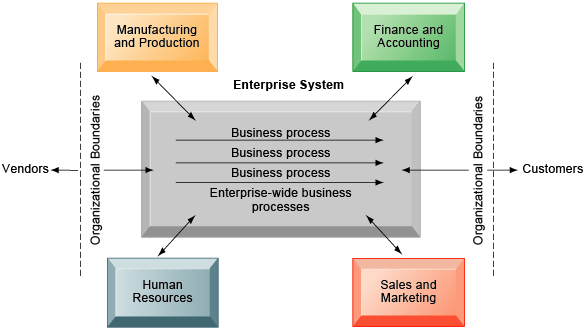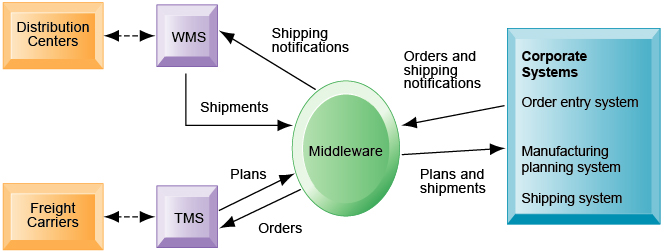| Section 2.3: Bullet Text Study Guide |
Systems that Span the Enterprise
Enterprise applications are systems that span functional areas, focus on executing business processes across the business firm, and include all levels of management. Enterprise applications help businesses become more flexible and productive by coordinating their business processes more closely.
There are four major enterprise applications:
Each of these enterprise applications integrates a related set of functions and business processes to enhance the performance of the organization as a whole.
Figure 2-11

FIGURE 2-11 ENTERPRISE APPLICATION ARCHITECTURE
Enterprise applications automate processes that span multiple business functions and organizational levels and may extend outside the organization.
The enterprise system collects data from various key business processes and stores the data in a single comprehensive data repository where they can be used by other parts of the business. Managers emerge with more precise and timely information for coordinating the daily operations of the business and a firm-wide view of business processes and information flows.
Figure 2-12
 |
|
SCM systems increase firm profitability by lowering the costs of moving and making products and by enabling managers to make better decisions about how to organize and schedule sourcing, production, and distribution.
Supply chain management systems are one type of interorganizational system because they automate the flow of information across organizational boundaries. Firms that skillfully manage their supply chains get the right amount of products from their source to point of consumption with the least amount of time and the lowest cost.
Figure 2-13
 |
|
The value of a firm's products and services is based not only on its physical resources but also on intangible knowledge assets. Some firms perform better than others because they have better knowledge about how to create, produce, and deliver products and services. Knowledge management systems support processes for discovering and codifying, sharing, and distributing knowledge, as well as processes for creating new knowledge and integrating external sources of knowledge.
Companies that do not have the resources to invest in enterprise applications can still achieve some measure of information integration by using intranets and extranets.
- Intranets typically present information to employees through a private portal that provides a single point of access to information from several different systems and to documents using a Web interface. Corporate portals often feature e-mail, collaboration tools, and tools for searching for internal corporate systems and documents. Companies can connect their intranets to internal company transaction systems, enabling employees to take actions central to a company's operations, such as checking the status of an order or granting a customer credit.
- Extranets expedite the flow of information between the firm and its suppliers and customers. They can allow different firms to work collaboratively on product design, marketing, and production.
Electronic business, or e-business, refers to the use of digital technology and the Internet to execute the major business processes in the enterprise. E-business includes activities for the internal management of the firm and for coordination with suppliers and other business partners. It also includes electronic commerce, or e-commerce. E-commerce is the part of e-business that deals with the buying and selling of goods and services over the Internet. It encompasses activities supporting those market transactions, such as advertising, marketing, customer support, security, delivery, and payment.
E-government refers to the application of the Internet and networking technologies to digitally enable government and public sector agencies' relationships with citizens, businesses, and other arms of government. In addition to improving delivery of government services, e-government can make government operations more efficient and also empower citizens by giving them easier access to information